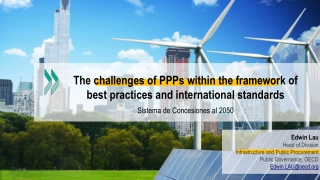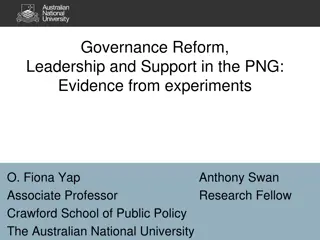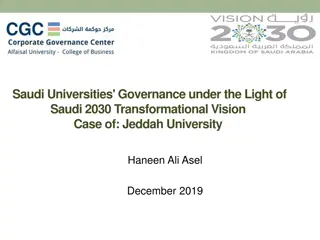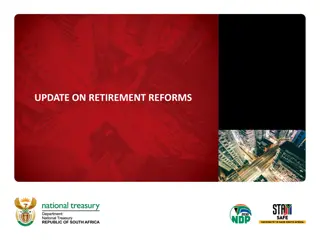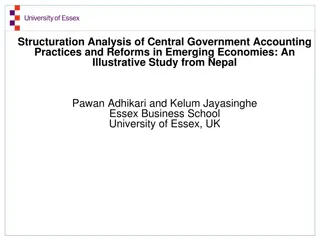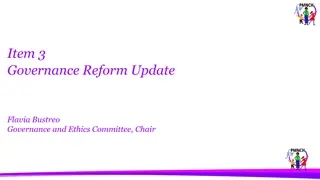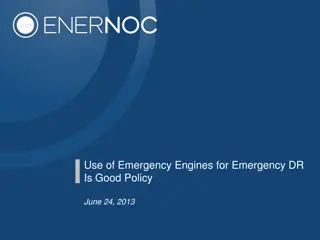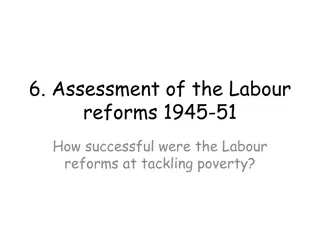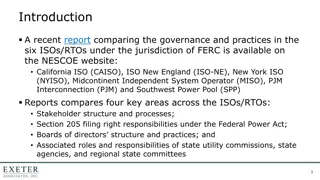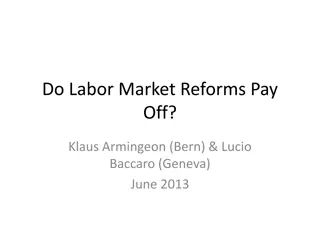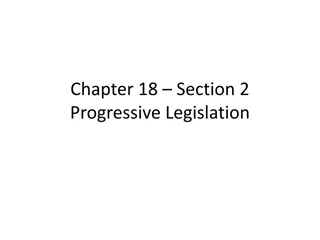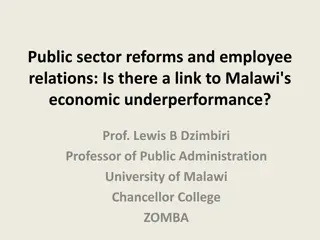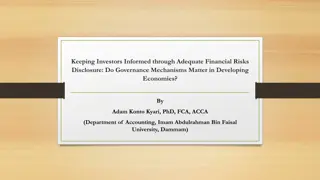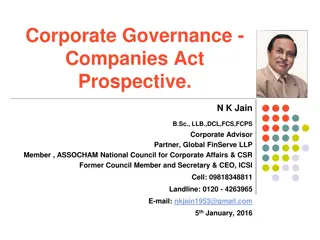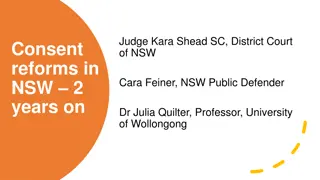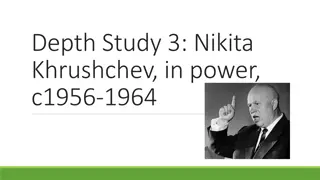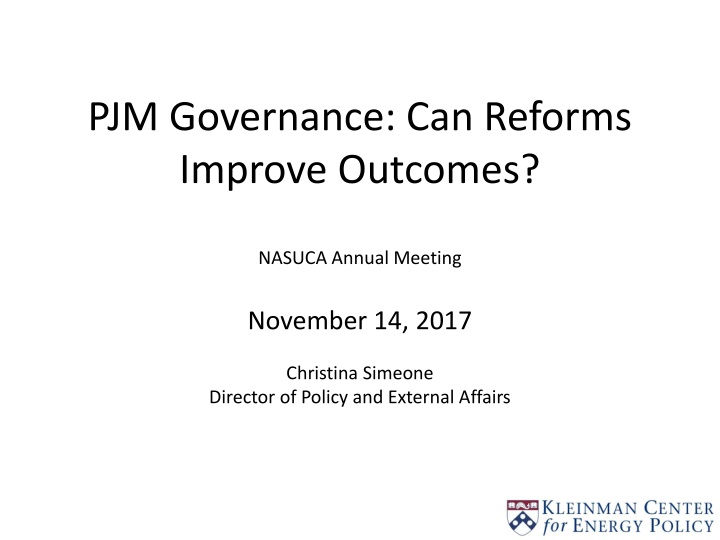
Examining Potential Reforms in PJM Governance
This presentation delves into the governance structure of PJM and examines the effectiveness of current processes in decision-making. It evaluates the evolution of governance actions with market changes and questions the representation of different member sectors. The exploration raises critical considerations for enhancing outcomes within the PJM system.
Download Presentation

Please find below an Image/Link to download the presentation.
The content on the website is provided AS IS for your information and personal use only. It may not be sold, licensed, or shared on other websites without obtaining consent from the author. If you encounter any issues during the download, it is possible that the publisher has removed the file from their server.
You are allowed to download the files provided on this website for personal or commercial use, subject to the condition that they are used lawfully. All files are the property of their respective owners.
The content on the website is provided AS IS for your information and personal use only. It may not be sold, licensed, or shared on other websites without obtaining consent from the author.
E N D
Presentation Transcript
PJM Governance: Can Reforms Improve Outcomes? NASUCA Annual Meeting November 14, 2017 Christina Simeone Director of Policy and External Affairs
About Us Kleinman Center for Energy Policy: Alumni-funded center at the University of Pennsylvania that works to advance research and education on energy policy issues. Focus on advancing student education and opportunities, supporting faculty research, and conducting applied research. Governance paper was supported solely by Kleinman Center funding.
Quick Refresher on Basic Framework Two Senior Standing Committees One vote per Member, no affiliate voting Sector-weighted voting with 2/3 majority to pass Acclamation voting Federal Power Act Filing Rights Tariff PJM/Board have 205 rights Five Member Sectors Generation Owner Other Supplier Transmission Owner End User Electric Distributor OA Members have 205 rights Stakeholder process is in the OA Numerous Lower Level Committees Affiliate voting (one company may have many votes) Simple majority to pass Votes disclosed as %, not broken out by sector 3
Does the Process Work? Very effective when issues less contentious (i.e. acclamation voting). Less effective on smaller number of high- contention issues (i.e. sector weighted vote). MRC Votes in 2015, 2016 Conclusion Unremarkable Typical of multi-stakeholder processes. Yet, it is still unclear if the stakeholder system is optimally designed to navigate contention and yield compromise.
Has the Process Evolved with Markets? Major Governance Actions FERC Order 719 in 2008 FERC Technical Conference in 2010 PJM s GAST process 2009 2011 Minor actions PJM s bi-annual stakeholder satisfaction surveys PJM s regular stakeholder forums During the same time span: Two presidential admins with very different views Change in PJM leadership Market disruptions (gas/renewables/zero load growth/financial products) Technology advancements Membership increases Almost a decade of operational experience Maturing of market, increased complexity of market design
Example - Do Member Sectors Still Represent Participants? New Market Entrants in growth sectors: Renewable Energy (G.O.) EE (E.D./T.O./O.S.) DR (O.S.) Marketers/Traders (O.S.) Concerns: Lack of unique voice Discourages participation of disadvantaged Larger sectors reduce individual firm impact Also - Supplier Advantage @ Lower Level Voting
Do Legacy Deals Still Make Sense? Members own the process via FPA 205 rights Legacy Deals split structural advantage in decision making process and enabled agreement on process. Example: Structural split in process, use of affiliate votes. Proposed Solutions (Supplier Advantage) Final Vote (Buyer Advantage) Problem Agenda (Buyer Advantage) Lower level no transparency on vote behavior of affiliates, clear advantage in proposal design phase.
RTO as a Quasi-Governmental Organization National Performance Review initiative Benefits Avoids expanding federal bureaucracy Develops new revenue sources to fund operations Exempt from federal central management laws (e.g. compensation limits) Economic-focused values (e.g. use of markets) Entity-specific laws and regulations for flexibility Drawbacks Accountability? More difficult to control, less responsive to preferences of political superiors, compared to traditional government agencies. To whom are these orgs accountable? How is the public interest being protected over private interests?
Are There Incumbent Advantages? In Theory RTO/ISO Bias academic literature presents many theories, which suggest incumbent, supply side bias. Yet to identify a buy-side or new entrant bias. In Practice Setting agenda of proposed solutions via lower level affiliate voting. Example: in SCSRTF, 190 votes cast by 34 respondents. Potential for just ten companies to prevent any proposal from passing. Concentration of resource ownership In 2015, over 77% of generation capacity needed to meet PJM s peak were controlled by just 10 companies. (Excludes reserve margin and renewables.) Resource burden to participate Time & money to participate. Can be addressed through agent. Technical expertise is hardest to level.
Recommendations FERC should require PJM (and other RTO/ISOs) to review and evaluate governance process, implement beneficial changes. Should require future evaluations at regular intervals. ongoing responsiveness principle of FERC Order 719 Explore issues identified herein. Greater and Enhance State Participation in PJM Including some method of formal voting, at least on high controversy issues. Non-conflicted (i.e. governor s office) States help define and represent public interest. FPA definition of public interest is narrow. Theory will greater involvement increase state understanding of issues, reduce impacts of political offensive, and reduce distortionary state policy? 10
http://kleinmanenergy.upenn.edu/paper/pjm-governance THANK YOU! csimeone@upenn.edu

